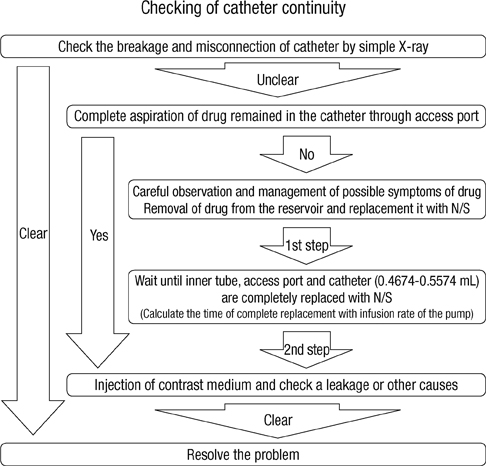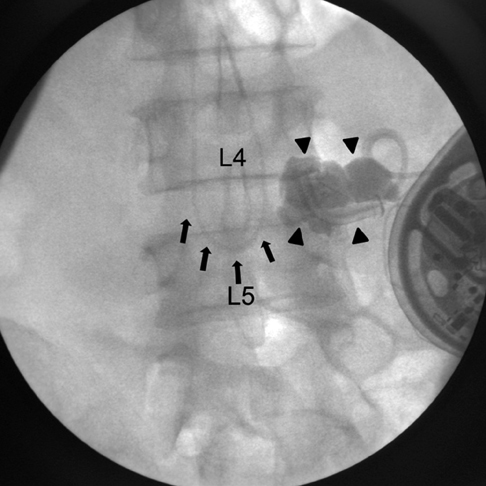J Korean Med Sci.
2012 Oct;27(10):1278-1281. 10.3346/jkms.2012.27.10.1278.
An Intrathecally Located Broken Catheter Used for an Intrathecal Drug Delivery System
- Affiliations
-
- 1Department of Anesthesiology and Pain Medicine, Konkuk University Hospital, Seoul, Korea.
- 2Department of Anesthesiology and Pain Medicine, Seoul National University Bundang Hospital, Seongnam, Korea.
- 3Department of Anesthesiology and Pain Medicine, Seoul National University Hospital, Seoul, Korea. soo02@snu.ac.kr
- KMID: 1778840
- DOI: http://doi.org/10.3346/jkms.2012.27.10.1278
Abstract
- The intrathecal drug delivery system (ITDDS), an effective treatment tool for intractable spasticity and pain, is associated with various complications but breakage of the catheter is rare. We report the case of a 50-yr-old man with ITDDS, in whom an intrathecal catheter was severed, resulting in a 28.6-cm-long intrathecal fragment. The catheter completely retracted into the intrathecal space from the anchor site. The catheter was severed during spine flexion, and the total distal fragment was repositioned in the intrathecal space. Although the outcome of ITDDS was associated with the length or diameter of the broken catheter, no neurologic complications occurred in our patient. Thus, we inserted another catheter instead of removing the old one. Thereafter, the patient has been regularly followed up, and no neurologic complications have developed during the 28 months.
MeSH Terms
Figure
Reference
-
1. Belverud S, Mogilner A, Schulder M. Intrathecal pumps. Neurotherapeutics. 2008. 5:114–122.2. Cohen SP, Dragovich A. Intrathecal analgesia. Anesthesiol Clin. 2007. 25:863–882. viii3. Jones RL, Rawlins PK. The diagnosis of intrathecal infusion pump system failure. Pain Physician. 2005. 8:291–296.4. Ruan X. Drug-related side effects of long-term intrathecal morphine therapy. Pain Physician. 2007. 10:357–366.5. Williams BS, Christo PJ. Obstructed catheter connection pin discovered during intrathecal baclofen pump exchange. Clin J Pain. 2009. 25:256–259.6. Fluckiger B, Knecht H, Grossmann S, Felleiter P. Device-related complications of long-term intrathecal drug therapy via implanted pumps. Spinal Cord. 2008. 46:639–643.7. Miele VJ, Price KO, Bloomfield S, Hogg J, Bailes JE. A review of intrathecal morphine therapy related granulomas. Eur J Pain. 2006. 10:251–261.8. Li TC, Chen MH, Huang JS, Chan JY, Liu YK. Catheter migration after implantation of an intrathecal baclofen infusion pump for severe spasticity: a case report. Kaohsiung J Med Sci. 2008. 24:492–497.9. Ko WM, Ferrante FM. New onset lumbar radicular pain after implantation of an intrathecal drug delivery system: imaging catheter migration. Reg Anesth Pain Med. 2006. 31:363–367.10. Motta F, Buonaguro V, Stignani C. The use of intrathecal baclofen pump implants in children and adolescents: safety and complications in 200 consecutive cases. J Neurosurg. 2007. 107:32–35.11. Vodapally MS, Thimineur MA, Mastroianni PP. Tension pseudomeningocele associated with retained intrathecal catheter: a case report with a review of literature. Pain Physician. 2008. 11:355–362.12. Follett KA, Naumann CP. A prospective study of catheter-related complications of intrathecal drug delivery systems. J Pain Symptom Manage. 2000. 19:209–215.13. Knight KH, Brand FM, McHaourab AS, Veneziano G. Implantable intrathecal pumps for chronic pain: highlights and updates. Croat Med J. 2007. 48:22–34.14. Ugboma S, Au-Truong X, Kranzler LI, Rifai SH, Joseph NJ, Salem MR. The breaking of an intrathecally-placed epidural catheter during extraction. Anesth Analg. 2002. 95:1087–1089. table of contents.15. Olivar H, Bramhall JS, Rozet I, Vavilala MS, Souter MJ, Lee LA, Lam AM. Subarachnoid lumbar drains: a case series of fractured catheters and a near miss. Can J Anaesth. 2007. 54:829–834.16. Simmerman SR, Fahy BG. Retained fragment of a lumbar subarachnoid drain. J Neurosurg Anesthesiol. 1997. 9:159–161.17. Forsythe A, Gupta A, Cohen SP. Retained intrathecal catheter fragment after spinal drain insertion. Reg Anesth Pain Med. 2009. 34:375–378.18. Hurley RJ, Lambert DH. Continuous spinal anesthesia with a microcatheter technique: preliminary experience. Anesth Analg. 1990. 70:97–102.19. Vender JR, Hester S, Waller JL, Rekito A, Lee MR. Identification and management of intrathecal baclofen pump complications: a comparison of pediatric and adult patients. J Neurosurg. 2006. 104:9–15.
- Full Text Links
- Actions
-
Cited
- CITED
-
- Close
- Share
- Similar articles
-
- Role of Catheter's Position for Final Results in Intrathecal Drug Delivery. Analysis Based on CSF Dynamics and Specific Drugs Profiles
- The Intrathecal Drug Administration System
- Upper body cancer pain management by cervical intrathecal catheterization: A case report
- Suspected transcutaneous cerebral spinal fluid leakage without postural headache after implantable intrathecal drug delivery system removal: A case report
- Clinical Observation of the CNS Depression following Intrathecal Injection of Morphine




